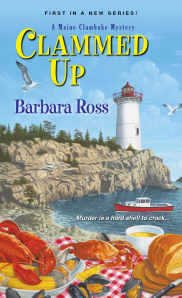Sherry Harris's Blog, page 37
September 30, 2014
Guest: Michael Nethercott
Edith again, happily on a solo writing retreat in Maine
We welcome our fellow New England author Michael Nethercott today. His new 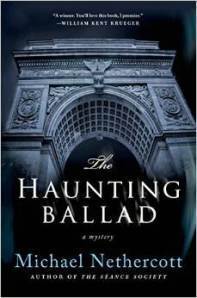 book, The Haunting Ballad (St. Martin’s Press), is the second whodunit in his traditional 1950s mystery series. It takes place in Greenwich Village and features the sleuthing odd couple from The Séance Society: private eye Lee Plunkett and scholarly Irishman Mr. O’Nelligan. Take it away, Michael!
book, The Haunting Ballad (St. Martin’s Press), is the second whodunit in his traditional 1950s mystery series. It takes place in Greenwich Village and features the sleuthing odd couple from The Séance Society: private eye Lee Plunkett and scholarly Irishman Mr. O’Nelligan. Take it away, Michael!
Cultural Currents
Blog entry: It’s the spring of 1957, and amidst the swirling music scene of New York’s Greenwich Village, a controversial songcatcher—a folk song collector—has died. Apparently, one late-winter’s night, she climbed to the roof of her apartment building and jumped over the edge. Jumped—or was she pushed?
That’s the kickoff of my new novel, The Haunting Ballad. In looking for a locale/theme for the latest entry in my mid-1950s series, I asked myself what cultural currents were in motion at that time. Well, one particularly lively one was the folk music movement that was just starting to skyrocket in ’57. In the urban centers such as New York and San Francisco, this movement overlapped with the rebellious Beat scene spearheaded by 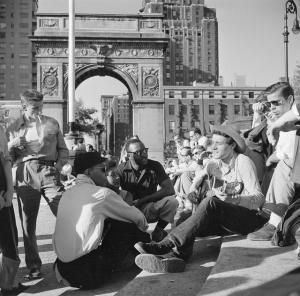 such scribes as Ginsburg and Kerouac. The Village, in particular, became an epicenter for all manner of colorful, dynamic, idiosyncratic goings-on. Seemed like a good place for mayhem.
such scribes as Ginsburg and Kerouac. The Village, in particular, became an epicenter for all manner of colorful, dynamic, idiosyncratic goings-on. Seemed like a good place for mayhem.
I found myself mentally flipping through the catalogue of musicians whose careers were thriving—or on the verge of taking off—in that time and place: Bob Dylan, Joan Baez, Odetta, the Clancy Brothers, and the various blues singers whose music was finding a new audience. This colorful crowd became an inspiration as I carved out my characters and plot threads. In my writing, I very much take my cue from the Golden Age mystery novelists—Agatha Christie, Rex Stout, Dorothy Sayers, etc.—and I take the “whodunit” piece seriously. I try to give the reader a large assortment of possible guilty parties. In this tale, the songcatcher’s demise leads Plunkett and O’Nelligan to a pretty varied jumble of suspects. There’s the bluesman with a checkered past, the eccentric coffee house owner, the moody Bohemian poetess, the boisterous clan of Irish balladeers, and a former Civil War drummer boy who has a hundred and five years under his belt.
Then there’s Mrs. Pattinshell, who labels herself a “ghost chanter”—meaning she sings songs that she claims the spirits of the dead have taught her. I grew up in a vast extended Irish family where presumably true ghost stories were bandied about like ping-pong balls. This definitely influenced me as an author. Something of the supernatural, the ghostly, always seems to find its way into my stories, and the present novel is no exception. Matter of fact, Mrs. Pattinshell’s spooky ditties are at the heart of the mystery. Hence the book’s title.
 When I first created my detectives, I opted for an unconventional spin on the standard buddy team. Young Lee Plunkett is a reluctant private eye who inherited the family business from his rough-and-tumble father. Somewhat deficient in both the rough and the tumble departments, Lee also has his limits as a deducer. That’s where Mr. O’Nelligan comes in. In the tradition of the gentleman sleuth, Mr. O’Nelligan lends his wit, wisdom and deductive chops to the inexperienced Lee. The well-read, quirky Irish immigrant can freely quote Celtic poets, Shakespeare or Elvis Presley. Also in the mix is Lee’s “perpetual fiancée” Audrey. In the course of the case, just to complicate things, Audrey is entranced by.one particular suspect—a handsome, slick young songwriter who has designs on her. This threat to Lee and Audrey’s relationship is at the core of [image error]the tale.
When I first created my detectives, I opted for an unconventional spin on the standard buddy team. Young Lee Plunkett is a reluctant private eye who inherited the family business from his rough-and-tumble father. Somewhat deficient in both the rough and the tumble departments, Lee also has his limits as a deducer. That’s where Mr. O’Nelligan comes in. In the tradition of the gentleman sleuth, Mr. O’Nelligan lends his wit, wisdom and deductive chops to the inexperienced Lee. The well-read, quirky Irish immigrant can freely quote Celtic poets, Shakespeare or Elvis Presley. Also in the mix is Lee’s “perpetual fiancée” Audrey. In the course of the case, just to complicate things, Audrey is entranced by.one particular suspect—a handsome, slick young songwriter who has designs on her. This threat to Lee and Audrey’s relationship is at the core of [image error]the tale.
Fortunately, I have an old friend who lives in the Village, whom I was able to stay with for a few days as I was doing my research. Though more than a half century has passed since the time of the folk music revival, I was able to walk those sidewalks and cobblestones and imagine what once was. I could almost catch the lost strains of acoustic guitars drifting down a corridor of phantom coffee houses. It sounded good…
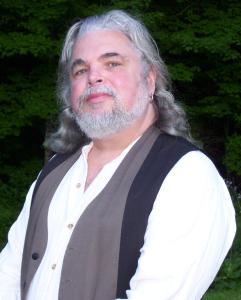 Readers: What are your favorite cultural currents from the past?
Readers: What are your favorite cultural currents from the past?
Michael Nethercott’s work has appeared in numerous magazines and anthologies including Alfred Hitchcock Mystery Magazine, Best Crime and Mystery Stories of the Year, and the Level Best anthologies. He is a Shamus Award finalist and a past winner of The Black Orchid Novella Award, The Vermont Playwrights Award, and Vermont Writer’s Award. Visit Michael Nethercott’s website and Facebook page.
Filed under: Guest posts Tagged: Greenwich Village, Michael nethercott, St Martin's Press, The Haunting Ballad

September 29, 2014
Welcome Leslie Budewitz!
Liz here, and today we have with us the lovely and talented Leslie Budewitz, author of the 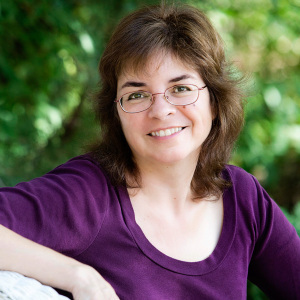 Agatha-award winning Food Lovers’ Village Mysteries and the brand new Spice Shop Mysteries. Leslie sat down to talk with me about her books, her characters and her favorite reads these days – and there’s even a shoutout to our own Barbara Ross!
Agatha-award winning Food Lovers’ Village Mysteries and the brand new Spice Shop Mysteries. Leslie sat down to talk with me about her books, her characters and her favorite reads these days – and there’s even a shoutout to our own Barbara Ross!
Your Food Lovers’ Village Mysteries take place in Jewel Bay, Montana, a fictional Bigfork. You’re always posting such beautiful pics of where you live on Facebook. Does your fictional town mirror a lot of your real world?
It really does. I live in a part of the country—NW Montana, on the road to Glacier National Park—justifiably known for its great natural beauty. But beyond the scenery and the outdoor recreation, this little village—like Jewel Bay—surprises people who don’t expect great art, food, theater, and increasingly, live music in a rural western community of less than five thousand. It’s those contrasts that make it such a great setting for a cozy mystery.
And of course, the characters. Boy, do we have characters!
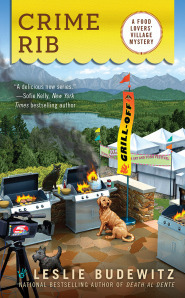 Tell us how Erin came to be. Is she like you at all? Did you have someone in mind when you wrote her?
Tell us how Erin came to be. Is she like you at all? Did you have someone in mind when you wrote her?
Erin Murphy is a lovely young woman, if I do say so myself. Like many characters, she came to life largely on her own: “black Irish,” with dark hair and eyes, but fair skin on a sweet, heart-shaped face. Not at all like her striking Italian-American mother Francesca, called Fresca. Like me, she grew up in Montana but left for several years, returning at 32. It’s a common story and one I wanted to explore through the eyes of a much younger woman. And like me, she’s devoted to her community and committed to supporting local business. We also share the experience of having a name that does not fully reflect one’s heritage, a subtle influence and a source of humor. And we both drive Subarus, but they’re so common around here, that’s no surprise!
Erin has business talents I can only envy. She manages her Spreadsheet of Suspicion with the ease of a cat pouncing on a mouse. Oh, there’s another similarity: We both inherited a sable Burmese cat from an elderly friend.
It’s great fun to write about a young woman making big decisions: to leave a career and return home to remake—and salvage—the family business, to choose a mate, how to deal with her loving but occasionally intrusive mother and sister.
The big difference: She’s courageous—and curious—enough to go after killers. Me, I’d call 911, lock the doors, and turn on all the lights!
I’m so interested in mother/daughter dynamics. Tell us about Erin and her mom, with whom she has a bit of conflict.
Fresca was widowed tragically when Erin was a senior in high school. She made the decision to shield her youngest child from her own pain—a decision with consequences fifteen years later, when Erin returns to Jewel Bay. Since her husband’s death, Fresca’s been running his family business, but she’s more passionate about pasta than retail, and recognizes that Erin has the skills and drive to make the struggling Merc succeed. Still, inviting an adult child to take over and actually giving her the reins are two different things. That conflict is the primary source of tension between the two.
At heart, they love, respect, and enjoy each other. I’ve been able to draw on observations of other families—especially those in business together—as well as my own. Of course, when you give a real-life experience to a fictional character, it changes—sometimes surprising even me!
Your recipes are amazing! How do you come up with them?
Thanks! I admit, I get a little carried away with the food! Each book involves a festival, so the recipes enable the reader to recreate some of the festival food at home. Other recipes describe dishes Erin eats at home, with her family, or in one of the village’s many restaurants. In both Death al Dente and Crime Rib, a recipe plays a role in solving the mystery.
Some come from my own collection; others I’ve found or created to fit the story. All have been thoroughly tested and carefully written so that both novice and experienced cooks can have as much fun with the food as Erin and I do.
What’s the best book you’ve read this year?
Ooh, tough question! The one downside of writing is that I don’t get to read as much as I used to, and sometimes can’t keep up with series I love. Two I can’t get enough of are Louise Penny’s Gamache novels and Alan Bradley’s Flavia DeLuce tales. I’m also dying to find out what happens next in Barbara Ross’s Maine Clam Bake mysteries!
What’s next in Jewel Bay?
After two books set in summer tourist season, it’s time for a good winter tale. Butter Off Dead (Berkley Prime Crime, July 2015) The merchants of Jewel Bay try to heat up chilly winter business with a new film festival. But their plans are sent reeling when a dangerous killer dims the lights on a local mover and shaker …
I’m also really excited about Assault and Pepper, first in my Spice Shop Mysteries, set in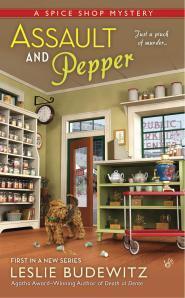 Seattle’s venerable Pike Place Market (Berkley Prime Crime, March 2015). Pepper Reece, owner of the Seattle Spice Shop, thinks she can handle any kind of salty customer—until a murderer ends up in the mix…
Seattle’s venerable Pike Place Market (Berkley Prime Crime, March 2015). Pepper Reece, owner of the Seattle Spice Shop, thinks she can handle any kind of salty customer—until a murderer ends up in the mix…
And of course, there will be tons of recipes—because I just can’t help myself!
Thanks for stopping by, Leslie! Readers, questions for Leslie? Leave them here and she’ll stop by to answer them!
Leslie Budewitz is the bestselling author of the Food Lovers’ Village Mysteries and the Seattle Spice Shop Mysteries. She is passionate about food, great mysteries, and her native Montana. Also a lawyer, Leslie won the 2011 Agatha Award for Best Nonfiction for Books, Crooks & Counselors: How to Write Accurately About Criminal Law & Courtroom Procedure, making her the first author to win Agatha Awards for both fiction and nonfiction.
Leslie loves to cook, eat, hike, travel, garden, and paint—not necessarily in that order. She lives in northwest Montana with her husband, a musician and doctor of natural medicine, and their Burmese cat, an avid bird watcher.
Visit her at http://www.LeslieBudewitz.com and on Facebook as Leslie Budewitz Author
Filed under: Guest posts Tagged: Agatha-award winning, Food Lovers' Village Mysteries, Leslie Budewitz, Spice Shop Mysteries

September 26, 2014
Ask the Editor — Jane Haertel
We are so happy to have our next guest editor, Jane Haertel, join us today. Read and learn!
 Name: Jane Haertel, Crazy Diamond Editing Services (www.crazydiamondediting.com)
Name: Jane Haertel, Crazy Diamond Editing Services (www.crazydiamondediting.com)
Area of Expertise: Romance of any shade, Young Adult, New Adult
How did you become an independent editor? A few years ago, a friend who was preparing to indie publish her YA novel asked me to proofread for her. My fussbudget nature would not allow me to leave it at a simple proofread, though, and I ended up copy and line editing the whole book for her, as well as providing content editing. Once I got started, I couldn’t stop, and I discovered that I had both a knack and a love for this part of the publishing process. After that, I picked up another client, who consistently began to hit the New York Times and USA Today lists of best-sellers, and through word of mouth I now have more than a dozen steady clients (several of whom hit the lists with every book).
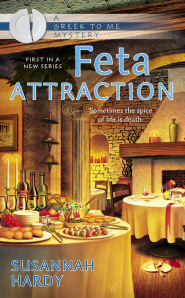 What are three things we should know about your area of expertise? Everyone—are you listening?—everyone needs an editor. (Yes, even me. Especially me.) When you’re all excited to indie publish something, and you’ve been over your manuscript a few times, it’s so tempting to think: Oh, in high school I was great at grammar and spelling, so I can save myself some coin by doing my own editing. Or: I’ve been writing for years. I’m not paying someone for something I can do myself. Wrong. You know what you meant to say, but that might not be what comes out on the page. And in general, your mom/sister/best friend is probably not the best person to do editing of any kind on your book. They love you, and they won’t want to hurt your feelings. Hire a professional. No matter your skill level, you need an objective, experienced set of eyes on your work.
What are three things we should know about your area of expertise? Everyone—are you listening?—everyone needs an editor. (Yes, even me. Especially me.) When you’re all excited to indie publish something, and you’ve been over your manuscript a few times, it’s so tempting to think: Oh, in high school I was great at grammar and spelling, so I can save myself some coin by doing my own editing. Or: I’ve been writing for years. I’m not paying someone for something I can do myself. Wrong. You know what you meant to say, but that might not be what comes out on the page. And in general, your mom/sister/best friend is probably not the best person to do editing of any kind on your book. They love you, and they won’t want to hurt your feelings. Hire a professional. No matter your skill level, you need an objective, experienced set of eyes on your work.
Editing is expensive. Sorry, but it’s true. It takes many, many, many hours to make just the first pass through a full-length manuscript, and this is how we editors make our livings. Especially for authors who are independently publishing their first works, there is a tendency to look for the lowest price and fastest turnaround. I wrote a book, darn it, and I want to start making my millions immediately. I can’t afford to hire an editor (or proofreader, professional cover artist, formatter). I would argue that you can’t afford not to assemble the best possible team to get your work out there. The market is glutted right now with indie books and getting good editing (and proofreading, and cover art, and formatting) is something you can control. If you want to make it in the indie world, you have to produce a product that is on a par with books published by New York houses. And yes, that costs money.
Still not convinced? Think about it this way. Writing and publishing books is a business. Would you expect to start, say, a knitting shop without providing any capital upfront for retail space, inventory, staffing? And, oh, open your doors to the public before all these things were in place? Of course not. That would be crazy, right? Putting your indie book out for sale is no different.
So get creative if you have to raise the money to hire professionals. If you have a special skill, perhaps you can barter services. I have edited in exchange for personal training, and for cookies. Which, now that I think about it, should probably be mutually exclusive. There’s probably stuff in your house that you can sell on eBay or Craigslist. Can you take on some freelance work of your own, such as cooking, sewing or knitting/crocheting for hire? Or take on a few hours of overtime at your day job? How about eating at home instead of going out to dinner? That’s the same as earning $50 or more, money that you can put toward your dreams. It’ll be worth the sacrifice upfront when the money from your beautifully professional book starts rolling in!
What do people usually get wrong? Good writing is not necessarily grammatically correct. In fact, perfect grammar makes fiction stilted and inaccessible to the reader. But there are some rules that should not be broken. Here are the mistakes I see most frequently:
Alright, alot. These are not words. Use all right and a lot.
Misuse of the apostrophe. This is perhaps my biggest pet peeve. Never, ever use an apostrophe to form the plural of anything. Example: Peach’s For Sale. Who is Peaches? What’s she selling? See what I mean? And the other most common assault on the poor apostrophe is the various formations of the word its. The only time that word should have an apostrophe is if you can replace it with it is or it has, never to show possession.
Adverbs. Okay, I’ll let you in on a little secret. I’m not one of those people who thinks that every –ly construction should be eradicated from a manuscript. Most, yes. But they don’t bother me as long as the author uses them … sparingly. And try not to end a sentence with an adverb like sparingly, LOL!
Misuse of the forms of the verb to lie. (Lay, lain, laid) The rules are too long to list, but here’s a link to a site that may help. http://www.quickanddirtytips.com/education/grammar/lay-versus-lie?page=all
Using dialogue tags other than said. Ninety-eight percent of the time, said is all you need. You want the reader focusing on your characters’ words, not getting distracted because you tried to get creative. “Hand me that glass of water,” he spouted/hissed/emitted/etc., etc. Once in a while, okay. But don’t make a habit of it.
And my personal pet peeve, the word smirk. Please, please, please. Unless your character is an annoying adolescent, or an adult acting like an annoying adolescent, do not have him/her smirking. A smirking character is automatically unlikeable. So, particularly in romance, but this holds true for other genres, do not let a main character perform this juvenile action.
Is there a great idea you’d love to share? Here’s a bit of my personal hoodoo. If you are stuck in the middle of a project, or you have finished a project and sent it off somewhere, perhaps to a potential agent or publishing house and you’re waiting on the outcome, go clean something that hasn’t been cleaned in a long time. Even better, get unwanted stuff out of your house—not just moved to another spot, but actually thrown away or donated. Still better, tackle something that you’ve been putting off or avoiding and that has been nagging at you. For example, if you hate going to the dentist, make—and keep—that appointment. Call an old friend you’ve been meaning to get back in touch with. The more things you do, the quicker and better the magic works.
 You see, making space in your head and your life allows new, wonderful things to come in. Nature abhors a vacuum. It works every time, but not always in the way you expect it. I did a lot of cleaning and decluttering while I was querying agents, and I not only got the call from an amazing agent, I got a three-book contract, all in a two-week span.
What are you working on? As an editor, I’m working on a juicy New Adult novel for a very good writer, so it hardly feels like a job, LOL!
You see, making space in your head and your life allows new, wonderful things to come in. Nature abhors a vacuum. It works every time, but not always in the way you expect it. I did a lot of cleaning and decluttering while I was querying agents, and I not only got the call from an amazing agent, I got a three-book contract, all in a two-week span.
What are you working on? As an editor, I’m working on a juicy New Adult novel for a very good writer, so it hardly feels like a job, LOL!
Readers: Jane will be available to answer your editing questions throughout the day.
Jane Haertel, who writes as Susannah Hardy, attended St. Lawrence University, graduating with a degree in history, and has worked as a waitress, handbag designer/manufacturer, paralegal, and currently as an editor of independently published short stories, novellas and novels at www.crazydiamondediting.com. She serves on the board of directors of the Connecticut Romance Writers of America and is a member of Sisters in Crime. Jane lives in Connecticut with her husband, teenaged son, and Elvira the Wonder Cat. You can connect with her alter ego, Susannah Hardy, at www.susannahhardy.com, on Twitter: @susannahhardy1, and on Facebook: https://www.facebook.com/pages/Susannah-Hardy/111056935644467 Her first novel, FETA ATTRACTION, releases January 6, 2015 from Berkley Prime Crime.
Filed under: Ask the Expert Tagged: Crazy Diamond Editing, editing, Feta Attraction, Greek to Me Mysteries, Jane Haertel, New Adult Novels, Susannah Hardy

September 25, 2014
Maine Clambake Series Renewed!
by Barb, in Somerville, MA, where it’s indisputably fall
We Wicked Cozies have a tradition of announcing good news here on the blog. Julie Hennrikus announced her new Clock Shop Mystery series. And more recently, both Edith Maxwell and Liz Mugavero shared happy news with our readers.
I’m thrilled to announce that my Maine Clambake Mystery series has been extended for books 4, 5 & 6. I’m excited about this because I have so many more stories to tell about the Snowden family, Morrow Island and Busman’s Harbor, Maine.
The planned books take place in late fall, winter and early spring–or as we call them in Maine, in winter, winter and more winter. The resort town of Busman’s Harbor is very different in the off season.
The books are tentatively titled Fogged In, Iced Under and Elvered After.
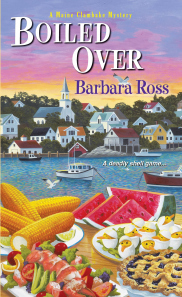 In Fogged In, the body of a stranger appears in the walk-in refrigerator of Gus’s restaurant. And we all know how Gus feels about strangers in his restaurant, much less dead ones. When the body yields no ID, Julia must help the police uncover the man’s identity and the mysterious reason for his visit to Maine.
In Fogged In, the body of a stranger appears in the walk-in refrigerator of Gus’s restaurant. And we all know how Gus feels about strangers in his restaurant, much less dead ones. When the body yields no ID, Julia must help the police uncover the man’s identity and the mysterious reason for his visit to Maine.
In Iced Under, Julia investigates her maternal ancestry and the disappearance of her mother’s cousin Hugh, who left Morrow Island on the eve of his twenty-first birthday and disappeared. She discovers some dark truths about her mother’s family that lead her to a modern-day case of murder.
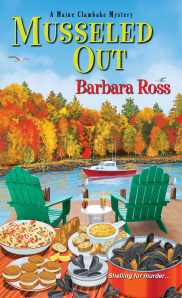 In Elvered After, a man is murdered in one of the Victorian bedrooms of the Snuggles Inn. He’s a Maine state official in town to regulate the local catch of elvers, the tiny, translucent baby eels that bring Maine fishermen as much as $2600 a pound and are sold to Asian farms to be raised for sushi. With high stakes, a short season, a limited number of highly-prized licenses and finite fishing grounds, the elver fishery provides plenty of suspects and reasons for murder. (I’m sure the publisher won’t let me keep the title because no one knows what elvers are, but it’s kind of perfect, isn’t it?)
In Elvered After, a man is murdered in one of the Victorian bedrooms of the Snuggles Inn. He’s a Maine state official in town to regulate the local catch of elvers, the tiny, translucent baby eels that bring Maine fishermen as much as $2600 a pound and are sold to Asian farms to be raised for sushi. With high stakes, a short season, a limited number of highly-prized licenses and finite fishing grounds, the elver fishery provides plenty of suspects and reasons for murder. (I’m sure the publisher won’t let me keep the title because no one knows what elvers are, but it’s kind of perfect, isn’t it?)
I’m working on Fogged In now, and can’t wait to find out what happens!
It’s hard to believe how much has happened since the first book in the series, Clammed Up, was published a year ago this month. Thank you for a wonderful year to friends, family, and Maine Clambake Mystery fans. I’ve been so honored by the reception these stories have found and hope you will enjoy the new books.
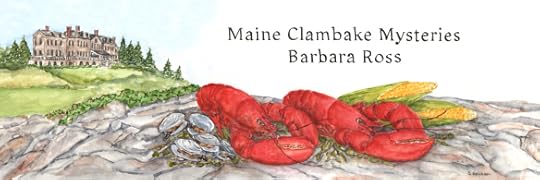
Filed under: Barb's posts Tagged: boiled over, clammed up, Elvered After, Fogged In, Iced Under, Maine Clambake Mystery, musseled out

September 24, 2014
Wicked Wednesday: SINC-Up, part two
Sisters in Crime is sponsoring a September SINC-Up, to spread the good word about good books and their authors. They suggested a few questions, so we selected one for last week and one for today. Part of the challenge is also to link to another author’s or authors’ blog, so each of us is doing that, too. The guidelines are here, if you’d like to take part. Just be sure to tweet your link using the hashtag #SinC-up or #SinCBlogHop and include @SINCnational.
The question for today:
What’s the best part of the writing process for you? What’s the most challenging?
Barb: Okay, I’ll go first. As I’ve said here before. I hate first drafts. Hate them. If I could figure out how to do the writing process without them, I would. They put me into a total vortex of self-doubt–every single time. “This is a short story idea. At best a novella. This will never be novel length.” “I know the beginning and the end, but I honestly don’t think you can get from here to there.” “This is boring, boring, boring. And stupid.” Etc. But give me something to revise, no matter how crude, and I am happy, happy happy. I can work all day. And short story or novel, I’ll happily work through a dozen or more drafts. I also love the “pre-writing phase” when all things are possible. So everything but the first draft.
For blogs, I want to recommend the Writers Who Kill blog. E.B. Davis has interviewed me twice, once for Clammed Up and once for Boiled Over. She asks such great questions. She always makes me think in new ways about my characters. The other posts and interviews are high quality, too.
Julie: Boy, this is tough for me. The entire process is a terrible joy. I do like the plotting/noodling stage. And I plot ahead of time, so it takes some time. But having just gone through the process (and am awaiting for notes from my editor), I would say I enjoy the first draft. I love the feeling when it all starts clicking, and the book surprises me. Or a character tells me a secret that helps shape the book.
My blog hop for this week is our New England chapter of SInC’s blog–Pen, Ink, and Crimes. There are lots of contributors to the blog, which makes it fun. And Hank Phillippi Ryan has been doing series of interviews that are just terrific.
Edith: I love “terrible joy” – Julie, that’s brilliant.
 Sherry: Sometimes I have a hard time forcing myself to sit in the chair and type. I’m easily distracted. Lunch with friends? Sure. Laundry? Sure. Time to walk Lily? Sure. Dusting? No — I have to draw the line somewhere. I think part of the forcing myself to sit is what Barb experiences with the first draft — the editor in my head telling me it’s all terrible. Last week I started writing Murder As Is the third in the Sarah Winston Garage Sale Series. I typed a line and a half and my computer froze. When I rebooted it, all that was there was the title. I figured the line was so bad even my computer couldn’t stand it.
Sherry: Sometimes I have a hard time forcing myself to sit in the chair and type. I’m easily distracted. Lunch with friends? Sure. Laundry? Sure. Time to walk Lily? Sure. Dusting? No — I have to draw the line somewhere. I think part of the forcing myself to sit is what Barb experiences with the first draft — the editor in my head telling me it’s all terrible. Last week I started writing Murder As Is the third in the Sarah Winston Garage Sale Series. I typed a line and a half and my computer froze. When I rebooted it, all that was there was the title. I figured the line was so bad even my computer couldn’t stand it.
My blog hop is Carstairs Considers. Mark not only does book reviews but also TV shows and Hallmark ornaments. It’s fun to read and he is a thoughtful book reviewer.
Jessie: I love to tear into a second draft and start revising. I find it so satisfying to play with the raw material and to coax it into the thing I really want it to be. I wish I loved first drafts as much. I don’t think I hate them as much as Barb but it I do find them a bit of a slog. Planning scenes before I start to write helps to keep my internal editor at bay but sometimes he scrambles over all my carefully constructed barriers anyway.
My blog recommendation this week is Live to Write, Write to Live, featuring our own Julie Hennrikus. The posts are insightful and the writers are engaging.
Julie: Thanks Jessie!
Edith: For me the magical part is when characters do something I didn’t expect. I’m typing away on a first draft, or in revision, and bingo, a woman falls off her chair. I stare at her in my mind, on the page, and think, “Whoa, she just fell off her chair. Why’d she fall off her chair? Did she have a heart attack? Vertigo? Was she poisoned? Is she faking it? And I WROTE IT. It doesn’t always happen, but it’s so special when I’m just channeling my characters.
The most challenging for me is surprising the reader while still being fair to her. I want you to catch your breath at the end, but I can’t drop it on you all at once – when you go back, you have to be able to realize that the clues were there all along. This is a very tricky thing to pull off, and I’m still working on it.
For blogs: gee, agree about all of the ones already mentioned, of course. I’ll recommend Ramona DeFelice Long’s blog on editing. If you go back through her archives, there are fabulous instructive posts for writers.
Readers: add your response!
Filed under: Wicked Wednesday Tagged: Carstairs Considers, distractions, EB Davis, first drafts, Live to Write Write to Live, Writers Who Kill, writing process

September 23, 2014
Guest: Janet Cantrell
Edith, on the second day of fall
We’re delighted to welcome our friend Kaye George/Janet Cantrell to the blog today. 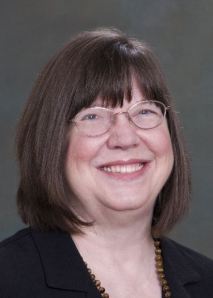 Kaye (which is already a pen name, apparently) is a past president of the Guppies, is the bestselling and Agatha-nominated author of four series, plus short stories, and is a super friendly, super generous person – and obviously super productive, too! Take it away, Janet, and welcome to the slash name club.
Kaye (which is already a pen name, apparently) is a past president of the Guppies, is the bestselling and Agatha-nominated author of four series, plus short stories, and is a super friendly, super generous person – and obviously super productive, too! Take it away, Janet, and welcome to the slash name club.
Me? A Cozy Author?
I never thought I’d be a cozy writer. My first attempts at writing, for years and years, were aimed at Serious Literature. Deep themes, delving into the depths of the dark soul of man. With alliteration.
One day I decided I wanted to stop collecting rejection slips and get published. My favorite reading was mystery, so I turned to that. Not cozies, though, more like traditional Agatha Christie and Nero Wolfe stuff. After a mere ten years and hundreds of rejections, I had success getting some of those published. I’m very proud of each and every one, too.
But there were those adorable, cute cozy covers in the bookstores. And prominent placing. So after another mere two years of pretty much continuous effort and lots more rejection, I secured a contract for the Fat Cat cozy series! To be honest, at this moment, this is the top of my Mount Everest. I submitted my traditional, humorous mystery, CHOKE, to the woman who is now my agent (after submitting many proposals previously). Kim Lionetti read it and liked my voice. During the phone call that cemented our relationship, she asked if I could write a cozy, because CHOKE is not a cozy, despite what some reviews have said. I assured her I could.
But could I? I was very careful to keep on the cozy track writing FAT CAT AT LARGE. These are the differences I noticed between writing a cozy and writing other mystery types.
The murder. Blood can be mentioned, but not vividly described and not dwelt upon. The body has to be there, of course, but more gruesome murder methods are to be avoided. In SMOKE, the victim was found hanging in the smokehouse on a meathook, naked. That would never do for a cozy. The body in the first in this series is merely lying on the floor with a knife sticking out of his chest.
The sex. My editor has been reining me in. She wants it to go very slowly. In fact, it’s not sex, it’s a romance. A slowly budding romance with lots of hurdles thrown in the way. Of course, I would throw those in anyway, but two characters might reach a passionate kiss a lot earlier.
The sleuth. Chase Oliver, the sleuth in FAT CAT is somewhat older than my other sleuths. Cressa Carraway, of EINE KLEINE MURDER, is in grad school. Imogene Duckworthy is in her very early twenties. But Chase is in her early thirties. She’s not going to be as flighty as the other two and will have the acumen to co-own a business, although she feels overshadowed by her much older partner, Anna Larson, at times. Chase has had better sense in the past than either Cressa or Immy, too. She hasn’t gotten pregnant by a nameless trucker and hasn’t gotten into a relationship with an abusive married man. True, she had a bad romance, but not as bad as my other characters.
The Point of View. I think cozies mostly stick to first person throughout. I feel pretty free to add other points of view in my traditional and my Neanderthal stories.
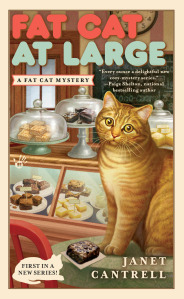 The jeopardy. Here, the genres converge more closely. I do believe in putting my character up a tree and throwing stones. After all, the sleuth has to deal with a murderer—has to uncover the culprit, and that’s dangerous business.
The jeopardy. Here, the genres converge more closely. I do believe in putting my character up a tree and throwing stones. After all, the sleuth has to deal with a murderer—has to uncover the culprit, and that’s dangerous business.
My dream was fully realized when I saw the cover of my cozy book. I couldn’t ask for anything better. I love all my other covers, but this one is totally a “cozy” cover, with the most adorable cat in the world.
Readers: Any other thoughts on what makes a cozy a cozy? Or do you disagree with any of mine?
Janet Cantrell is a pen name for Kaye George, Agatha nominated novelist and short story writer. She belongs to Sisters in Crime, Guppies, and Austin Mystery Writers. Her cozy Fat Cat mystery series debuted in September with the national bestseller, FAT CAT AT LARGE, featuring Quincy, a pudgy, adorable cat who is an accomplished escape artist. Especially when he’s on a diet and hungry. Leave it to Quincy to lead his human, Chase, co-owner of a Minneapolis dessert bar shop, into trouble. Janet lives in Knoxville, Tennessee with her husband. Her recently departed feline, Agamemnon, is a source for some of Quincy’s antics. Visit http://janetcantrell.com/ for more details. She blogs at: http://janetcantrell.blogspot.com/
Filed under: Guest posts Tagged: Barking Rain Press, Berkley Prime Crime, Eine Kleine Murder, Fat Cat at Large, Janet Cantrell, Kaye George

September 22, 2014
What To Bring With
Edith, writing furiously north of Boston on the Equinox
Ya can’t take it with you, isn’t that what they say? Well, I have learned that if I don’t take it with me, I’m in trouble. Specifically, what I bring along when I go sell books in public. So this post (by request from none other than Hank Phillippi Ryan) is all about being prepared to go sell books.
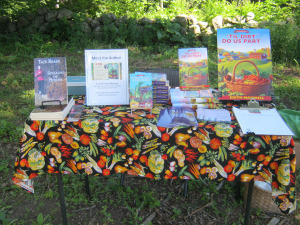 I sell books at libraries. I sell them at farmers’ markets. I sell them out of the trunk of my car, quite literally. At author expos, at historical societies, at road races. And I’ve assembled a kit of what to bring. I might not use it all, but I’m ready.
I sell books at libraries. I sell them at farmers’ markets. I sell them out of the trunk of my car, quite literally. At author expos, at historical societies, at road races. And I’ve assembled a kit of what to bring. I might not use it all, but I’m ready.
Books. Yes, books. Once I was astonished to see that I’d brought only two copies of my latest release. Yikes! I was all ready to take people’s money upon a promise to send them a signed book the next day, but I didn’t need to. Just. So now I always keep a full box of all my books in my car.
Signage. I finally got a table-sized banner made. It wasn’t expensive, and my
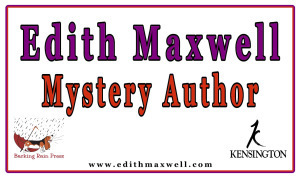 local party store made it up to my specs. My publisher also prints up my cover every year into a self-standing poster, so I bring the latest one. And I have several home-printed signs in a clear stand with a graphic, my name, Mystery Author, and a few other details. Clear large print and uncluttered display, so people can read it as they drift by.
local party store made it up to my specs. My publisher also prints up my cover every year into a self-standing poster, so I bring the latest one. And I have several home-printed signs in a clear stand with a graphic, my name, Mystery Author, and a few other details. Clear large print and uncluttered display, so people can read it as they drift by.Tablecloth. I write a farm-based series, so I found this gorgeous vegetable cloth (see first picture) and hemmed it up. But even a clean plain white cloth dresses up a market table.
Table. Ah, yes, the table. I found a four-foot table at Staples. It’s easy to assemble, folds in a snap, and isn’t too heavy or too long to hoist in and out of my small car.
Chair. I bring a folding chair, unless the facility provides it (also see Table). But I rarely sit. It’s a lot easier to draw customers in if I stand. And yes, my feet hurt at the end of the two- or three- or five-hour period.
Book stands. Right now I have a mish-mash. I like the black wire one best for not tipping over, but it
 doesn’t collapse. Still experimenting. I hear the Container Store has a great selection. I got mine at Joann’s Fabrics in their craft section.
doesn’t collapse. Still experimenting. I hear the Container Store has a great selection. I got mine at Joann’s Fabrics in their craft section.Bookmarks. Some print up postcards. I prefer bookmarks, one per series.I also bring business cards, because they have my email address on them, but I give them out less often. Even when someone stops by my table who is interested but clearly not going to buy, I hand them a bookmark. They’re a big hit with kids, and who knows? Maybe their grandmother, who loves mysteries, will see the bookmark and check out who that nice author was.
Email signup sheet. I print out a signup sheet, securing it on a clipboard, and
 invite anybody – everybody! – to sign up for my quarterly (or so) newsletter, making sure they know I never sell, loan, or rent my address list.
invite anybody – everybody! – to sign up for my quarterly (or so) newsletter, making sure they know I never sell, loan, or rent my address list.Suitcase. I use a small suitcase I already had. I know Jessie found a cool piece of luggage (designed for a salesperson, I believe) that has all kinds of cool pockets and slots, and is the perfect size for mass-market paperbacks. My suitcase fits the books, the table cloth, most of the signage, and the tool kit.
Tool kit.This cute metal carrot lunchbox, which someone gave me a birthday present in, holds many useful items, including all of the
 following: Square reader so I can take credit
following: Square reader so I can take credit
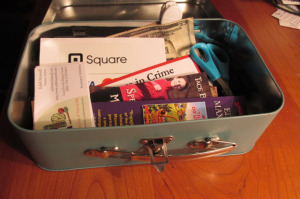 cards. Spare cash for change. Bookmarks. Business cards. Tape. Pens. Ribbon to tie my banner on with. Extra pens. Clips. Other clips. Paper clips. A tiny flashlight. Camera. Little scissors. I think it’s infinitely expandable. And it’s not crushable.
cards. Spare cash for change. Bookmarks. Business cards. Tape. Pens. Ribbon to tie my banner on with. Extra pens. Clips. Other clips. Paper clips. A tiny flashlight. Camera. Little scissors. I think it’s infinitely expandable. And it’s not crushable.So that’s my go-to-market/library/wherever list. Which only works when I’m driving to an event, of course. I find it refreshing to sell at a bookstore, because then they have the books, the table, the signage, sometimes even the tablecloth. I only bring the tool kit and maybe a sign. But extra books? Always in the back of the car. When I fly, I still bring the tool kit and a few extra books, and ship books ahead if I have to.
Readers: What do you take to author events? Or to a craft show, trade show, or other kind of event? Any additions to my list? Any good stories about when you forgot that once crucial thing? What kind of displays attract your eye?
Filed under: Craft, Edith's posts Tagged: author event, bookmarks, hank phillippi ryan, mystery, Square reader

September 19, 2014
Guest Arlene Kay
Edith, north of Boston
We’re pleased to welcome Arlene Kay, our fellow New England Sister in Crime, to the blog 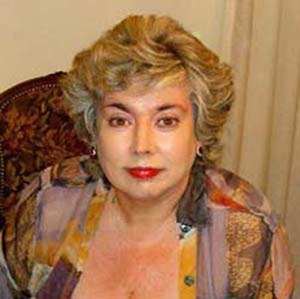 today. Listen to what this author who does NOT write cozies has to say.
today. Listen to what this author who does NOT write cozies has to say.
Sister Act
At first blush, cozy mysteries and romantic suspense resemble sparring siblings rather than members of the same genre. The proper cozy eschews depictions of sex while arching a disdainful brow at her uninhibited sister. Romance lovers often dismiss cozies as inhibited relics of a Puritan past. As a writer (and fan) of both sub-genres, I submit that while the antics and locales may vary, the underlying themes of cozy mysteries and romantic suspense are remarkably similar.
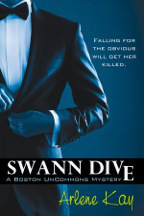 My Swann series is a case in point. Three of the novels take place in Boston; one is based on Cape Cod. Although the vibe is big-city snarky with a dollop of sex, the focus is clearly on friendship, family loyalty, betrayal and the tug of war between law and justice. These same issues permeate cozy mysteries from Christie to contemporary authors. Their timelessness provides enjoyment and a sense of satisfaction to a wide swath of readers.
My Swann series is a case in point. Three of the novels take place in Boston; one is based on Cape Cod. Although the vibe is big-city snarky with a dollop of sex, the focus is clearly on friendship, family loyalty, betrayal and the tug of war between law and justice. These same issues permeate cozy mysteries from Christie to contemporary authors. Their timelessness provides enjoyment and a sense of satisfaction to a wide swath of readers.
One final observation: Character and plot, not technical mumbo jumbo, are core components of both cozy and romantic suspense novels and indeed of all good writing. If a book lacks compelling characters or a logical plot it is a husk, an empty shell that pleases no one. Both sub-genres typically serve up a cast of sidekicks who supplement the skills of the heroine or fill in the gaps. These reflection characters also serve an important function: they are free to 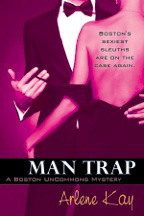 express the emotions of the reader. How many times have you yearned to throttle the hero who plunges into a situation fraught with danger or makes a serious blunder? Sidekicks have no problem stating the obvious question. “Are you crazy?”
express the emotions of the reader. How many times have you yearned to throttle the hero who plunges into a situation fraught with danger or makes a serious blunder? Sidekicks have no problem stating the obvious question. “Are you crazy?”
Even Malice Domestic, that bastion of cozy mysteries has adopted the big tent approach to the crime genre. A recent panel discussion at Malice 2014 tiptoed around the sex issue (Shot Through the Heart: The Role of Romance in Mysteries) and, in an asterisk to the Cozy Mystery Definition, noted that “adult situations” were now becoming common even in traditional mysteries.
Bottom line: romantic suspense and cozy mysteries share the same classic bloodlines and often appeal to the same audiences. No need for a family squabble.
Arlene Kay’s most recent books include the Boston Uncommons Mysteries Swann 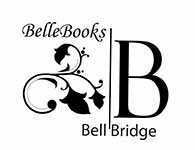 Dive, Mantrap, Gilt Trip, and Swann Song, published by Belle Books. Arlene is a former federal executive with one of those alphabet agencies, who traded the trappings of bureaucracy for the delights of murder most foul. She wisely confines her crimes to fiction. An artful combination of humor, sex, and savagery make Arlene Kay’s mysteries unique.
Dive, Mantrap, Gilt Trip, and Swann Song, published by Belle Books. Arlene is a former federal executive with one of those alphabet agencies, who traded the trappings of bureaucracy for the delights of murder most foul. She wisely confines her crimes to fiction. An artful combination of humor, sex, and savagery make Arlene Kay’s mysteries unique.
Readers: Do you read romantic suspense? For you, what’s the same and what’s different between romantic suspense and cozy mystery?Or pop Arlene a question – she’ll be stopping by throughout the day to answer.
Filed under: Guest posts Tagged: Arlene Kay, Belle Books, Boston Uncommons Mysteries, romantic suspense, Swann novels

September 18, 2014
It’s All A Plot
By Julie, putting away her summer clothes in Somerville
We’ve talked about being a pantser versus a plotter a few times on the blog. (Here, here, and here, for example.) Sherry Harris still talks about the expression on my face when she told me she wrote the end of her book before she wrote the middle. The Clock Shop Mystery series, which I am writing as Julianne Holmes, came with a book bible, which suited me fine. I not only enjoy a roadmap, I require one.
Because, dear friends, I am a plotter. And I’ve got a new toy, er…tool, to help me. Here it is.
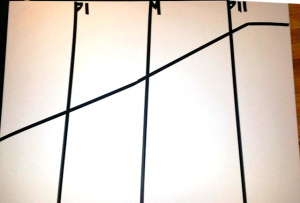
Poster Board with dramatic structure guidelines.
I just submitted my first Clock Shop manuscript. I had broken it into scenes, and used Scrivener, but I didn’t pay enough attention to the dramatic structure. This affected the pacing, and the story telling, and got fixed in editing, but still. Yeesh. There had to be a better way for a plotter like me. I read Jessie’s post last week about her process, and was inspired by her use of post-its. I decided to steal the idea, but since I don’t have a blank wall, I bought some poster board, and created a visual image to help me put the scenes in the right places.
This is a combination of the structure The Weekend Novelist Writes a Mystery and the three act dramatic structure narrative I know from theater. A beginning, a middle, more of the middle, and an end. Rising action, climax, falling action. The timing of the inciting incident–the problem that starts the story. Plot points or act turns–moments in the novel that complicate the problem, or reverse the reader’s expectations. The end, when it all comes to a head. And the denouement, where the reader (or audience) can relax a bit, and loose threads are tied up.
I am currently writing scene descriptions on post-its. I am also writing other scene descriptions that probably won’t be in the book (they take place in the past), but they inform the story. And finally, I am describing a few scenes from a subplot I am starting in the first book, want to continue in this book, and conclude in the third book. Once I have finished writing out the scene descriptions, I am going to put them on the board. And I am going to make sure the act breaks (plot points) fall in the right place, and have scenes that turn the action.
Confused? Hour long dramas are a great way to think about dramatic structure. (Law and Order, for example.) What was the hook that drew you into watching? What happens at the fifteen minute mark? What keeps you watching? Were you surprised while watching it? If the story fell apart, when and why?
Any other dramatic structure fans (nerds?) out there? Any fellow plotters?
Filed under: Julie's posts

September 17, 2014
Wicked Wednesday: SINC-Up
Sisters in Crime is sponsoring a September SINC-Up, to spread the good word about good books and their authors. They suggested a few questions, so we’ve selected one for this one and one for the following week. Part of it is also to link to another author’s or authors’ blog, so each of us is doing that, too. The guidelines are here, if you’d like to take part. Just be sure to tweet your link using the hashtag #SinC-up or #SinCBlogHop and include @SINCnational.
The question for today is:
Which male authors write great women characters? Which female authors write great 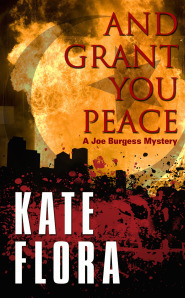 male characters?
male characters?
Edith: I love Kate Flora‘s Joe Burgess. Also Susan Oleksiw‘s Joe Silva. Both of these police officers are human, fully drawn, conflicted men I could like (a lot) in real life, and they don’t spend much (if any) time commenting on women’s legs and boobs. And I’m holding off on answering the first part, because my stupid brain is refusing to cooperate! Or more likely, it’s that I don’t read male authors much because they don’t write great female characters. But I’m glad to be proven wrong by the rest of you, readers included.
For those of you who love to eat, my SINC-Up this week is the Mystery Lover’s Kitchen blog – new recipes by mystery authors (including regular Wickeds contributor Sheila Connolly) every day!
Jessie: While not a mystery author, I believe Wally Lamb writes women incredibly well. In fact, while I was reading She’s Come Undone I kept turning to the author photo to try to convince myself the author was not a woman. In the mystery world I think Alan Bradley of Flavia de Luce fame does a wonderful job crafting an authentic voice for a young girl.
As to women writing men well, I feel unqualified to answer. I’d like to think the protagonist in Sara Gruen’s Water for Elephants rings true for men. The men in that book with smaller roles felt vivid and believable to me too.
For a blog recommendation I’d like to mention Dru’s Book Musing. She has regular guests, giveaways and reviews. Check it out for yourself!
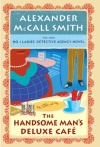 Barb: For a man who writes women well, I’m going with Alexander McCall Smith. From Mma Ramotswe and Mma Makutsi of the No. 1 Ladies Detective Agency series, to Isabel Dalhousie to the horrid little girl Olive from the 44 Scotland Street series, they all ring, in some cases hilariously, true. Smith is generous toward all his characters, no matter what their foibles, which is an inspiration to me.
Barb: For a man who writes women well, I’m going with Alexander McCall Smith. From Mma Ramotswe and Mma Makutsi of the No. 1 Ladies Detective Agency series, to Isabel Dalhousie to the horrid little girl Olive from the 44 Scotland Street series, they all ring, in some cases hilariously, true. Smith is generous toward all his characters, no matter what their foibles, which is an inspiration to me.
 Of course, women have written male detectives from the beginning, from Agatha Christie’s Hercule Poirot to Dorothy L. Sayers’ Lord Peter Wimsey to P.D. James’ Dalgliesh to Ruth Rendell’s Wexford. Continuing in that tradition, I have to give my shout out to Louise Penny. Her Gamache has that larger than life edge that makes him a great protagonist, but I often find her portrayal of Jean-Guy Beauvoir most affecting.
Of course, women have written male detectives from the beginning, from Agatha Christie’s Hercule Poirot to Dorothy L. Sayers’ Lord Peter Wimsey to P.D. James’ Dalgliesh to Ruth Rendell’s Wexford. Continuing in that tradition, I have to give my shout out to Louise Penny. Her Gamache has that larger than life edge that makes him a great protagonist, but I often find her portrayal of Jean-Guy Beauvoir most affecting.
Great blog recommendations, Edith and Jessie–two of my faves. I can’t let this first round go by without mentioning the Jungle Red Writers, who have, in one way or another, inspired all the Wicked Cozys.
Edith: Agree about Alexander McCall Smith! Love the Ladies Number One Detective Agency books.
Liz: Harlan Coben does a great job writing women. He’s spot on every time. I just listened to the audiobook of Hold Tight and while he does a great job in all the characters’ heads, the female protagonist is amazingly well done, as are the secondary women characters he writes in this standalone.
As far as women writing men, there are so many to choose from! I do love Julia Spencer-Fleming‘s Russ Van Alstyne in her long-standing series. These books are hauntingly captivating, and while the plots are terrific, it’s the characters that drive the books.
Along with the three blogs above, I also love Killer Characters, a fun blog spanning a wide range of authors including our own Jessie Crockett with a regular gig. All posts are written from a character’s perspective. Check it out!
Sherry: I love J.A. Jance’s J.P. Beaumont series set in Seattle. He’s flawed and authentic. Craig Johnson does a great job portraying Victoria Moretti and other women in his Longmire series. I’m so excited he will be at Crime Bake this year. Barbara Ross also blogs on the great Maine Crime Writers blog. It is about so much more than Maine and crime writing!
Julie: Late to the party, but jumping in. I always liked Robert B. Parker’s women, especially Susan. In thinking about it, it may be seeing her through Spenser’s eyes, but she had such an impact on the series. As for a blog to hop to, the Cozy Chicks are a very fun group!
Readers: add your response!
Filed under: Wicked Wednesday Tagged: #sinc-up, Alan Bradley, Alexander McCall Smith, Craig Johnson, Crime Bake, Dru's Book Musing, J.A. Jance, Joe Burgess, Joe Silva, kate flora, louise penny, Maine Crime Writers, Mystery Lovers Kitchen, Sara Gruen, Sisters in Crime Sinc-up, Susan Oleksiw, Wally Lamb


